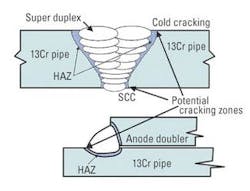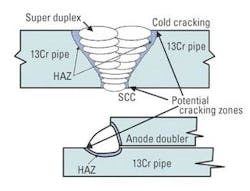Minimizing hydrogen cracking critical for 13Cr pipeline welds
Tricia Barnett
Subsea 7
For stainless steel flowlines, 13% chrom-ium (13Cr) provides excellent resistance to carbon dioxide attack, with good strength and toughness properties. The material has been qualified and used by many operators in high-temperature, high-CO2 containing environments, with slightly sour and non-sour conditions.
In fact, 13Cr is a slight misnomer, as the material has a martensitic microstructure and a general composition of 10-12% chromium, 4-6.5% nickel, and 0-2.5% molybdenum. The carbon content is maintained below 0.02%, classifying it as weldable.
Compared with other corrosion-resistant alloy line pipe materials, 13Cr's superior strength at elevated temperatures means that lighter wall thickness may be employed, reducing weight, raw material costs, and fabrication costs. To successfully implement the material, however, it is also important to appreciate and work within its boundaries.
Hydrogen cracking
The key to successfully fabricating 13Cr pipelines by welding is to minimize the potential for hydrogen cracking. Three conditions are required – a hydrogen source, a critical or threshold stress, and a susceptible (hard) microstructure.
Welding procedure qualification tests have revealed excellent impact toughness in the heat-affected zone of 13Cr, but there have also been documented failures where the presence of hydrogen has had a detrimental effect on the fracture toughness. The cooling rate and residual stresses affect the micro-structure and hardness of the heat-affected zone. This combines with a number of other factors, including significant hydrogen content in welding consumables and shielding gases, the presence of moisture, and a lack of cleanliness, to increase the metal's susceptibility to cold cracking.
The standard industry approach is to use super duplex welding consumables for over-matching corrosion resistance. However, the yield strength tends to under-match the parent pipe, and the austenitic phase of the duplex material stores hydrogen for a longer time, providing a potential source of hydrogen for subsequent loading. Failures of tie-in welds of reeled pipelines have shown that levels of hydrogen below 3 ppm in the welding wire are required as a standard. This level may be guaranteed by the consumable supplier, or alternatively achieved by baking at the annealing temperature in an inert vacuum furnace.
Matching 13Cr alloy consumables have also been applied for 13Cr welds, and good mechanical and corrosion resistance properties are achievable using gas tungsten arc welding. Laboratory evidence suggests that using match- ing welding consumables improves stress corrosion cracking resistance in the 13Cr heat-affected zone. But, higher weld metal hardness and a martensitic weld micro-structure mean that even lower hydrogen levels are necessary to prevent hydrogen-induced cracking.
Stress corrosion cracking resistance
13Cr materials are mildly resistant to sulfide and chloride-induced stress corrosion cracking. Recent failures indicate that the leaner grades of 13Cr may not be so resistant, with incidence of chloride stress corrosion cracking initiating from the root heat-affected zone.
There is no industry-agreed method for testing resistance to chloride and sulfide stress corrosion cracking of 13Cr materials. In general, the higher the content of molybdenum and nickel, the greater the resistance to stress corrosion cracking and pitting corrosion.
null
It is generally accepted that a short post-weld heat treatment cycle has a beneficial effect on stress corrosion cracking resistance. This is possibly due to a combination of chemistry "healing," a slight reduction in heat-affected zone hardness and relaxation in residual stress and hydrogen removal during this heat treatment cycle. For welds carried out with duplex stainless steel consumables, it should be ensured that the post-weld heat treatment raises the temperature quickly and that after a brief holding cycle (typically five minutes), the temperature is brought rapidly down to below 300° C to prevent sensitization.
Cathodic protection
Not resistant to seawater attack, 13Cr will undergo pitting when exposed to wet chloride-containing environments and oxygen at ambient temperatures. This effect is mitigated by using high integrity coating systems with an appropriate flowline cathodic protection design. 13Cr materials have been qualified as suitable for cathodic potentials of -1,100 mV. However the heat-affected zone at the anode doubler pad has elevated hardness and a propensity for stress raisers at the weld toe due to the fillet weld profile. Damage to the coating in the area of the anode attachments results in the production of hydrogen that diffuses into the heat-affected zone, causing embrittlement and increasing the risk of hydrogen-induced stress cracking.
Experience suggests that the potential difference between the anode and the parent material should be reduced.
Welding engineers must enforce a range of strict low hydrogen practices and ensure that appropriately engineered welding procedures are qualified and adhered to during production. The cathodic protection system must be designed with a reduced potential and with a high integrity coating system.

